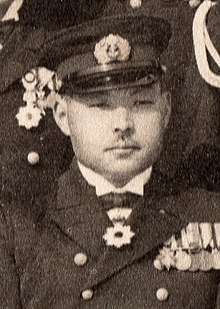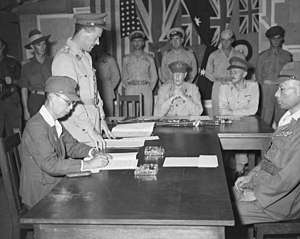Tomoshige Samejima
Vice Admiral Baron Tomoshige Samejima (鮫島 具重, Samejima Tomoshige, April 8, 1889 – September 13, 1966), was an admiral in the Imperial Japanese Navy during World War II.
Tomoshige Samejima | |
|---|---|
 Samejima in 1937 | |
| Born | April 8, 1889 Tokyo, Japan |
| Died | September 13, 1966 (aged 77) |
| Allegiance | |
| Service/ | |
| Years of service | 1909–1946 |
| Rank | |
| Commands held | Seito Kitakami Mogami Haguro Nagato Carrier Division 4 Cruiser Division 13 Carrier Division 2 4th Fleet 8th Fleet[1] |
| Battles/wars | World War II |
Biography
Samejima was the grandson of Iwakura Tomomi, and adopted by Admiral Samejima Kazunori a native of Satsuma Domain and noted figure in the Meiji restoration, Tomoshige Samejima graduated 51st of 179 cadets in the 37th class of the Imperial Japanese Navy Academy in 1909. He served his midshipman duty on the cruiser Soya and battleships Sagami, and Katori and as a sub-lieutenant on Aso, and Hashidate. After graduating from naval artillery and torpedo classes, he was assigned to the battleships Kashima and Kawachi followed by the destroyer Kaba. He was promoted to lieutenant in 1915. He subsequently served on the cruiser Azuma and battleship Kongō, and after a two-year tour as an instructor at the naval gunnery school from 1918–1920, he was reassigned to the battleship Mutsu. In 1921, he served as aide-de-camp to Prince Higashifushimi Yorihito and was promoted to lieutenant commander.[2]
From 1921-1923, he attended the Navy Staff College, and on graduation, served two years on the light cruiser Yura. From 1925-1927, he traveled to England, where he studied at his own expense. On his return to Japan, he was promoted to commander and assigned as aide-de-camp to Prince Takamatsu Nobuhito.
Samejima returned to sea as executive officer of the Haguro from November 1929 - November 1930. His first command was in 1931 as captain of the transport Seito.[3]

In 1931, with the First Shanghai Incident, Samejima served on the staff of the Japanese 1st Expeditionary Fleet and was promoted to captain. He was given command of the cruisers Kitakami from 1932 to 1934,[4] Mogami from 1934 to 1935,.[5] Haguro from 1935–1936 and the battleship Nagato from 1936 to 1937.
As rear admiral from December 1937, Samejima commanded Carrier Division 4 from 1937–1938, Cruiser Division 13 from August–September 1938, and Carrier Division 2 from September 1938 to October 1939.
From November 1939 to October 1942, Samejima served as Aide-de-camp to the Emperor of Japan, and was in this position at the time of the attack on Pearl Harbor. He was promoted to vice admiral in October 1941. From October 1942, Samejima returned to sea as commander of the IJN 4th Fleet, which was responsible for defending the South Pacific Mandate against counter-attacks by the Allied forces. From April 1943 to the surrender of Japan, Samejima served as commander of the IJN 8th Fleet.
He retired from active service in 1946 and died in 1966.
References
Notes
- Nishida, Materials of IJN
- Nishidah. imperial Japanese Navy
- Pacific War Online Encyclopedia
- "Imperial Cruisers".
- "Imperial Cruisers".
Books
- D'Albas, Andrieu (1965). Death of a Navy: Japanese Naval Action in World War II. Devin-Adair Pub. ISBN 978-0-8159-5302-9.
- Dull, Paul S. (1978). A Battle History of the Imperial Japanese Navy, 1941-1945. Naval Institute Press. ISBN 978-0-87021-097-6.
- Dupuy, Trevor N. (1992). The Harper Encyclopedia of Military Biography. HarperCollins Publishers.
- Fuller, Richard (1992). Shokan: Hirohito's Samurai. London: Arms and Armor. ISBN 978-1-85409-151-2.
- Morison, Samuel Eliot (1958). Breaking the Bismarcks Barrier, vol. 6 of History of United States Naval Operations in World War II. Castle Books. ISBN 978-0-7858-1307-1.
- Prados, John (1995). Combined Fleet Decoded: The Secret History of American Intelligence and the Japanese Navy in World War II. Annapolis: Naval Institute Press.
Web
- Budge, Kent G. "Samejima Tomoshige (1889-1966)". The Pacific War Online Encyclopedia. Retrieved 2007-11-08.
- Nishida, Hiroshi. "Materials of IJN: Samejima, Tomoshige". Imperial Japanese Navy. Archived from the original on 2012-07-09. Retrieved 2007-08-03.
| Military offices | ||
|---|---|---|
| Preceded by Inoue Shigeyoshi |
Commander-in-chief of the 4th Fleet 26 October 1942 - 1 April 1943 |
Succeeded by Kobayashi Masami |
| Preceded by Mikawa Gunichi |
Commander-in-chief of the 8th Fleet 1 April 1943 – 3 September 1945 |
Succeeded by Fleet Dissolved |